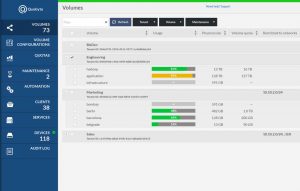Quobyte Data Center File System Software 2.0 for Management Complexity Out of Storage
For emerging workloads on Linux, Windows, Mac, Hadoop and S3
This is a Press Release edited by StorageNewsletter.com on November 23, 2017 at 2:32 pmQuobyte Inc. announced the release 2.0 of its Data Center File System software.
Click to enlarge
With this version of its software, customers can eliminate storage ‘silos’ and realize a single unified storage platform for unstructured data.
The software combines the linear scalability and a performance of a distributed, parallel file system with the lights-out reliability of cloud-style operations. The predictable performance, whether low latency or high IO/s, can be utilized by a variety of workloads such as those in commercial HPC, financial services, electronic design automation (EDA), media and entertainment, as well as Container infrastructures Kubernetes and Docker. The software delivers all benefits whether it is deployed on SSDs or ordinary HDDs in commodity servers.
“Quobyte’s vision from the outset has been to bring cloud scalability, agility, and cost-effectiveness to the enterprise“, said Bjorn Kolbeck, CEO, Quobyte. “Our 2.0 release is all about simplifying data center storage management and automating processes and tasks to reduce operational expenses.“
Click to enlarge
The Data Center File System provides R/W/access to files natively from Linux, Mac, Windows, Hadoop and S3. The version 2.0 goes a step further and also provides shared ACLs to preserve security and access as intended – applying the access control regardless of the access method/protocol used to get to the file. There is no need to duplicate the data in order to have multiple people working on the same file.
This software installs and configures in minutes and its data placement engine reduces complexity and management overhead. Data placement policies can be based on attributes such as file size or age, as well as by tenant/user or application. Policies can then be used to drive automated tiering, deliver performance isolation and enforce physical, device-level security.
Placement policies also define data protection, striping and block size. Because these storage functions are abstracted from the hardware and defined by policies, they can be changed in a matter of seconds, even on the fly. This allows administrators to provision storage based on application needs and just as reconfigure those same storage resources to be responsive to changing and emerging workloads.
“The migration to Kubernetes and Quobyte was done for scalability and performance. It has allowed us to grow the volume of transactions while at the same time decreasing transaction times.” Michael Laccetti, principal engineer, Points.com, Inc.
The version 2.0 release adds volume mirroring to the DR capabilities. Volume mirroring is continuous, asynchronous mirroring across geographies, continents and clouds.
The Data Center File System 2.0 software is available.















 Subscribe to our free daily newsletter
Subscribe to our free daily newsletter

